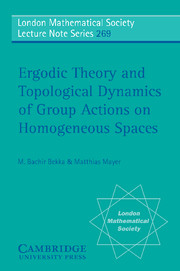Book contents
- Frontmatter
- Contents
- Preface
- Acknowledgment
- I Ergodic Systems
- II The Geodesic Flow of Riemannian Locally Symmetric Spaces
- III The Vanishing Theorem of Howe and Moore
- IV The Horocycle Flow
- V Siegel Sets, Mahler's Criterion and Margulis' Lemma
- VI An Application to Number Theory: Oppenheim's Conjecture
- Bibliography
- Index
III - The Vanishing Theorem of Howe and Moore
Published online by Cambridge University Press: 05 August 2013
- Frontmatter
- Contents
- Preface
- Acknowledgment
- I Ergodic Systems
- II The Geodesic Flow of Riemannian Locally Symmetric Spaces
- III The Vanishing Theorem of Howe and Moore
- IV The Horocycle Flow
- V Siegel Sets, Mahler's Criterion and Margulis' Lemma
- VI An Application to Number Theory: Oppenheim's Conjecture
- Bibliography
- Index
Summary
Let G be a locally compact group acting on a probability space X, and let π be the associated unitary representation. Recall that the action of G is strongly mixing if every matrix coefficient of π vanishes at infinity on G (see Chap. I, Definition 2.10).
The Vanishing Theorem of Howe and Moore states that matrix coefficients of arbitrary (non trivial) unitary representations of a simple Lie group vanish at infinity. This is a powerful theorem showing that many interesting flows are ergodic (and even strongly mixing). A typical application is as follows. Let G be a simple Lie group. Let Γ be a lattice and let H be a non-compact closed subgroup of G. Then the action of H on Γ \ G by right translations is ergodic. As we saw in the previous chapter, the geodesic flow of a locally symmetric space is related to flows of this type.
A more general application is Moore's ergodicity theorem which gives optimal conditions under which the action of a subgroup of a semisimple Lie group is ergodic or even strongly mixing (see Theorems 2.1, 2.5).
The theorem of Howe and Moore is first proved for SL(2, ℝ). The proof we present, due to R. Howe, is remarkable in that it essentially uses no representation theory. Again, a crucial rôle is played by Mautner's lemma (Chap. II, 3.6)
The extension to general semisimple Lie groups is a technical matter: one has to use sufficienly many copies of SL(2,ℝ) inside the given group. Here we follow [Vel].
- Type
- Chapter
- Information
- Publisher: Cambridge University PressPrint publication year: 2000



